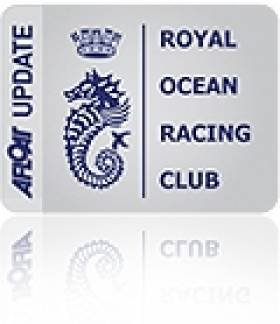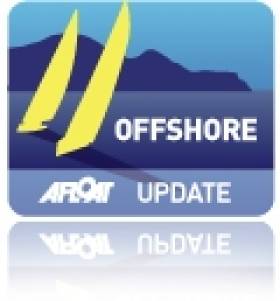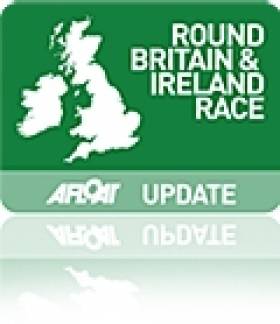Displaying items by tag: Mike Slade
#fastnet race – This year's 90th anniversary edition of the mighty Fastnet Race on August 16th will see a record fleet including two of the world's very newest maxis – Jim & Kristy Hinze Clark's 100ft Comanche and George David's exceptionally quick 88ft Rambler 88 - lining up against the likes of Mike Slade's veteran 100ft Leopard, which took line honours in 2007 and 2009.
In addition to the demands of racing, they're taking on a challenge of rugged sailing which George David knows only too well, as his Rambler 100 capsized at the Fastnet Rock itself in 2011's race after losing her canting ballast keel.
Whether with canting keels or using more orthodox methods of stability provision, the astonishingly varied 350-plus international fleet will be celebrating a great course and a major event which is now central to the panorama of world sailing. It is difficult to imagine the global sailing programme without the Fastnet Race in its biennial position of major importance. Yet getting it up and running in 1925 was a dogged struggle, worked through amidst fierce controversy.
And in contrast with today's large and totally international fleet, the "founding flotilla" was just seven boats, while the nearest it could claim to having an international element was through the presence of the 43ft cutter Gull from Cork. In unveiling Gull's distinctive contribution to the establishment of the Fastnet Race, W M Nixon begins by introducing us to an American description of Gull and her skipper. This colourful piece first appeared in a sailing magazine after the second Fastnet Race of 1926, and then achieved immortality by being included in Alfred F Loomis's seminal book Ocean Racing, first published 1936.
"The Gull was a plank-on-edge cutter of ancient vintage. She had a tremendous jackyard topsail, a terrific tiller, and a pack of wild Irishmen aboard her, who flogged the life out of her. As I recall, we were either first or second around the Fastnet. Shortly thereafter the mainsail started letting go and water came up over the floorboards because we'd spewed all our bow caulking. The glass dropped .80 inches in forty-five minutes, and on that came a regular Bristol Channel howler. In thick weather we groped for Baltimore, and when we got within what we estimated to be two miles and could not pick up the light, we reluctantly gave up the heroic idea of beaching the Gull there, caulking her, and still finishing. (Yes, that's the sort of skipper and crew it was!)
We hauled up for Cork Harbour, close-hauled under tri-sail and storm jib with the wind coming down now from about Sou'east, and that delightful Irish coast altogether too close under our lee. The seas were breaching clean over the old packet, and the spitfire jib – though we didn't know it – was pulling the runner eyebolt right out of the counter. We passed the Stag Rocks and they weren't more than two hundred yards to leeward; on the darkest, wildest sort of night they were plainly visible and audible, great and terrifying founts of spray just to leeward. This was possibly the closest escape I've ever had at sea, and one of the few times my life has actually been in danger.
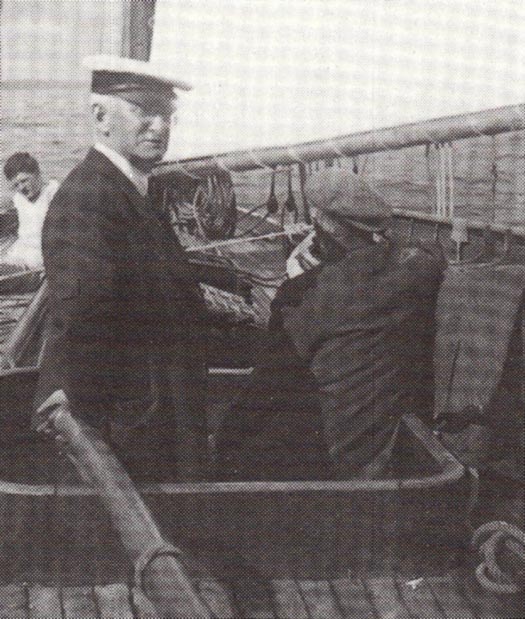
It was certainly no exaggeration to describe her as being steered with a "terrific tiller" - Harry Donegan on the helm.
Well, the old bucket held together until we put her on the mud at Crosshaven in the morning. All hands had pumped, bailed and cursed – I didn't hear any praying – all night long, and everything aboard was soaked.
While the mess was drying out in the sunlight this final morning I found my bedraggled, red-eyed, but still spunky little skipper fiddling around on deck with what to me looked suspiciously like a boy's toy. I asked him what he was doing, and his answer, s'helpmegawd, was,
"I'm flying a kite."
He went on to explain that he had meant to test out a theory that an aerial could best be carried by a kite when at sea, and so he had brought along a box-kite which had been forgotten until we started heaving the gear on deck. Discovering it at this late date, his intellectual curiosity remained strong enough to overcome the anxiety, desperate work and weariness of a rotten hard race and near-foundering.
His name is Henry P F Donegan, a solicitor of Cork, and he is one of the world's best."
Thus we have Harry Donegan and his beloved Gull, vividly remembered for all time in international sailing history. The piece may have several inaccuracies and any amount of poetic licence. But there's no doubting how it captures the spirit of a man who, with maybe just two or three others - if others there were at all – was present at both the founding of the Royal Ocean Racing Club in Plymouth at a dinner in the Royal Western Yacht Club on August 23rd 1925 after the finish of the first Fastnet Race, and at the founding of the Irish Cruising Club at a dinner in Glengarriff on July 13th 1929 after a Cruise-in-Company in West Cork. On both occasions, he had sailed there aboard Gull.
This particular account of a "rotten hard race and near-foundering" is about the second Fastnet Race of 1926, which was the first to start from Cowes. The first and decidedly controversial Fastnet Race of 1925 had only been able to secure a start from the Royal Victoria Yacht Club at Ryde, which sent the fleet out of the Solent eastabout.
The colourful yarn about the 1926 race was written by the American Warwick Tomkins, who had done a pierhead jump aboard the Irish boat at almost the last minute, and his impressions of Gull were perhaps slightly skewed. For sure, she certainly did have a "terrific tiller". Yet as she was built in 1896, she was only thirty years old at the time, which was scarcely "ancient vintage". As for being "plank-on-edge", that almost amounts to defamation - she had a beam of slightly over 10ft on an overall length of 44ft, which made her decidedly beefy by comparison with the true plank-on-edge lead-mines of the 1870s and 1880s.
In fact, Gull was a classy performance cruiser built by Camper & Nicholson at Gosport, and designed by a rising star in the family firm, Charles E Nicholson, who was twenty-eight when she was launched. But she set such an enormous spread of canvas that her shroud base had been widened by the use of channels, an archaic system which may have heightened her apparent antiquity for American eyes.
However, the "tremendous jackyard topsail" was if anything an understatement. The luff of this extraordinary sail was something like 50% longer than the luff of the mainsail. The idea of carrying - let alone sending aloft - this vast acreage of sail with its two long and heavy yards in open ocean seemed an appalling notion to conservatives who had doubted the wisdom of an "ocean race" from the very beginning.
And in truth it still seems an appalling notion to us today, with our roller furling sails and all conveniences. For us, Gull seems the epitome of labour-intensive danger-laden sailing, and in the fleet of just seven which raced in the first Fastnet, she was the only one which had any claims to be "yacht-like" – all the rest were variants on no-nonsense sailing working boats, with the eventual winner Jolie Brise being a 1913-built sailing pilot cutter which had worked out of Le Havre.
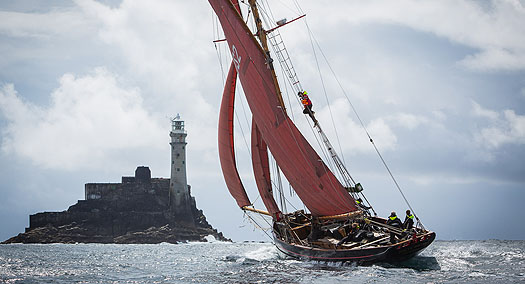
The winner of the first Fastnet Race was the former pilot cutter Jolie Brise, seen here at the fastnet while celebrating her Centenary at the Glandore Classics Regatta 2013. Photo: Brian Carlin
Failure is an orphan but success has many father, and with the 90th Anniversary Fastnet Race coming up in August with its record entry, the analyses are becoming ever more detailed in allocating the true credit for this first "Corinthian ocean race" in European waters.
In doing so, we are immediately into the problems of defining just what is meant by an "ocean race". After all, one of the earliest - if not the first - offshore distance races anywhere was from Dublin Bay to Cork Harbour, and it was sailed as long ago as 1860, the winner by a whisker being the amateur skipper Henry O'Bryen sailing the 39-ton cutter Sybil.
Then, in the final decades of the 19th Century, there were two or three Tranatlantic races – true ocean races - for enormous yachts sailed by professionals. But even though one started and another finished at Cork Harbour, they weren't seen as something to which Corinthian sailors could relate. In fact, one of the first relatively regularly-staged and truly oceanic races with amateur input was from California across the Pacific to Hawaii, inaugurated in 1906, but somehow the Transpac didn't receive the attention it deserved, possibly because it was sailed on warm water between places a long way from the true ocean – the Atlantic.
There, much more attention focused on the first Bermuda Race from New York, also in 1906, despite it having only three entries. But that had grown to twelve by 1907, yet it had fallen back to just two in 1910. The First World War intervened, then there wee two low-key revivals in 1921 and '22, but eventually in 1923 there was a serious move to revive the Bermuda Race, and the newly-formed Cruising Club of America took it under its wing. There were 22 entries, and since 1924 the 635-mile Bermuda Race has been an established biennial ocean classic.
However, in the higher latitudes and colder water of Western Europe, the yachting establishment centred around the Solent was very wary of such things. The attitude was that racers shouldn't go on the ocean, while boats fit to go on the colder parts of the ocean were incapable of meaningful racing.
But some disagreed. George Martin (1881-1945), a leading younger member of the Royal Cruising Club since 1905, was in favour of fast sailing, though it was just one of his many boat-centred interests. His family had founded Martin's Bank, while he had been awarded the RCC's premier trophy, the Challenge Cup, two years running in 1907 and 1908. These had been for intrepid ventures with a 35-ton 1903-built gaff cutter called Chance, one from his home waters in south Devon to Gibraltar and return, the other a circuit of Denmark from the same starting point, with Norwegian, Swedish and German ports being visited en route.
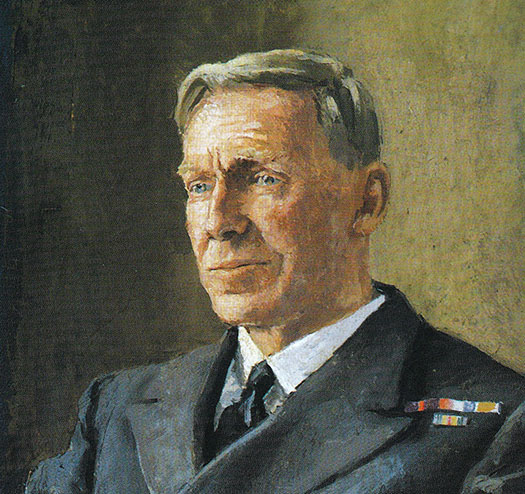
Lt Cdr George Martin OBE (1881-1945), founding Commodore of the Royal Ocean Racing Club and winner of the first Fastnet Race
Both cruises were made in fairly determined style, and Martin – a well-liked and gangling sort of man 6ft 7ins in height - had something of a reputation as a skipper who liked to push his boats to best performance. But when, eleven years later and shortly after he'd served in the RNR with distinction throughout the Great War, he began to make noises in favour of the RCC staging an "ocean race", he was rebuffed.
Things get a bit murky at this stage, as we can only go on the official club minutes, which often give a sanitized version of events. But what we do know is that in 1919 George Martin was put forward for Rear Commodore of the RCC by two very distinguished members, the maritime writer E Keble Chatterton and the already well-known cruising man George Muhlhauser, who soon afterwards was to make was to make a global circumnavigation with the 37-ton yawl Amaryllis for which he, like Martin in 1907 and 1908, was to be awarded the Challenge Cup in 1921 and 1922 (followed incidentally by Conor O'Brien with Saoirse in 1923, 24 & 25, but that's another story altogether).
Meanwhile in 1919, the possibility of the revolutionary George Martin with his wild notions of ocean racing becoming part of the RCC hierarchy seems to have caused considerable fluttering in the dovecotes of the serious cruising establishment, and Donald Cree – who had been Honorary Secretary of the RCC since 1908 but was under temporary replacement by his father Charles while he saw out his wartime service - stood against George Martin.
Despite the distinction of his proposers, Martin was roundly defeated by 129 votes to 49. The anti-ocean-racing mood of the club was clear. And as the RCC History (published for the club's Centenary in 1980) puts it: "Only a year later, and after a great deal of exertion on his part to become Rear Commodore, Cree resigned the office and again became Honorary Secretary. He was to be Honorary Secretary for the next 43 years, until 1964; in all he held the post for 52 years."
George Martin being a decent and well-liked man, he went on to do what he saw as the decent thing if he wished to persist in promoting ocean racing - he resigned from the Royal Cruising Club in 1921. However, he was Commodore of a Devon-based yacht club, the Royal South Western in Plymouth which was in process of amalgamating with the more senior Royal Western Yacht Club in the same port, of which in due course he became Commodore. This gave him some organisational muscle for further promotion of ocean racing.
By 1923 he had replaced the hefty Chance with a flying machine, the former Le Havre pilot cutter Jolie Brise. Built in 1913 and one of the last significant sailing pilot cutters built anywhere, her retirement from active work had been hastened by the accelerated technical advances in steam-driven seagoing vessels during the Great War. By 1917, Jolie Brise was redundant at Le Havre, and until George Martin took her over in 1923, her fate was uncertain as she had been of only limited use as a fishing boat.
Cometh the hour, cometh the man, cometh the boat. George Martin with the Jolie Brise needed a race of more than 600 miles from the Solent across the Western Approaches and back to Plymouth simply to express themselves. But despite his huge size, Martin was by nature diffident, and the most direct promotion for an ocean race in British waters came from a new direction entirely.
Enter offshore sailing enthusiast Joseph Weston Martyr (1885-1966), a former officer of the British army in the worst of the World War I trenches. He had worked post war in New York as a ship broker, but then took to maritime writing as a fulltime career while staying in America. In 1922, 1923 and 1924 he sailed in the Bermuda Race, the third time being aboard the schooner Northern Light. Although an error by the navigator meant they were totally last by the time they found the finish line, his enthusiasm was fired up, and he started bombarding British yachting magazines with ideas for an event of similar length on their side of the Atlantic.
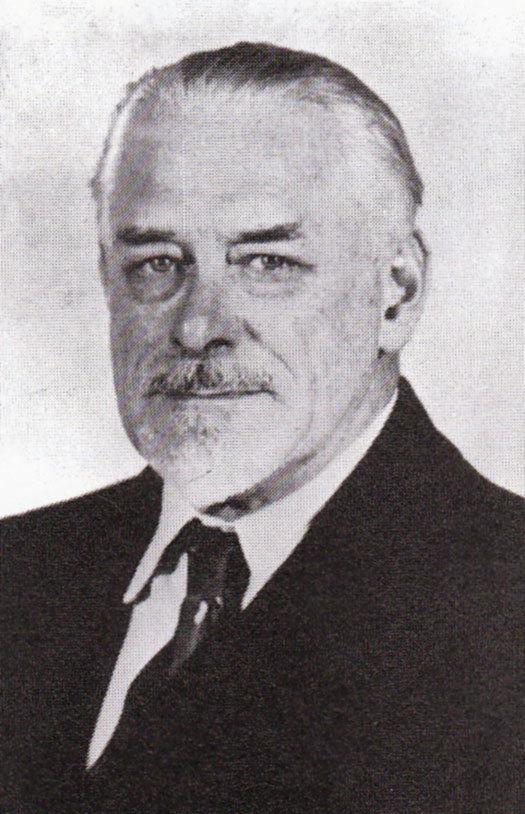
Weston Martyr, whose journalistic enthusiasm for ocean racing encouraged the movement towards establishing the Fastnet Race. He is equally well remembered for his classic of sailing literature The Southseaman – the Life Story of a Schooner (1926), a partially fictionalised yarn built around his experiences with the schooner Northern Light.
Both Yachting Monthly through its editor, and Yachting World through its publisher, got involved in the growing interest, so when cruising's most respected authority, Claud Worth the Vice Commodore of the Royal Cruising, felt obliged to comment, he did so in the pages of The Field. Worth had been upset by George Martin's resignation from the RCC, and a small part of him inclined to ocean racing, for he was no slouch in getting performance out of his own boats. But he was concerned that in the heat of competition, even the most sensible amateur seamen would drive their boats too hard downwind, and he wrote:
"At the risk of making an unpopular suggestion, I venture to express a doubt which arises in my mind – are our latitudes suitable for a public ocean race?......a public race might well include some owners whose keenness is greater than their experience. If the weather should be bad, so long as there is a headwind they would probably come to no harm, for a good boat and sound gear will generally stand as much driving as the crew can put up with. But when running before anything approaching a gale of wind in a big sea in open water, conditions are very deceptive......".
Yet by early 1925 the momentum towards a race round the Fastnet seemed almost unstoppable, so as a final input to the debate, Worth suggested that if an ocean race was indeed going to be held, then it should be a true ocean event clear of the hazards of skirting any coastline, taking the fleet from the south coast of England to northwest Spain. He even offered to sail out to La Coruna or Vigo to time the boats in at the finish.
However, a small private Ocean Race Committee had been formed by George Martin, Weston Martyr recently back from America, and Malden Heckstall-Smith, the Editor of Yachting Monthly, and the course was set from the Solent to the Fastnet and thence to the finish at Plymouth. The Morning Post of 7th March 1925 announced that "the Ocean Race shall be.....sailed under the flag of the Royal Western Yacht Club". Four entries were in before the month was out, and at one stage around July1st the list of potential competitors ran to fourteen boats, including an American yawl which promised to bring an international flavour.
But in the end, on August 15th just seven started, and Harry Donegan's Gull from Cork was the nearest thing to international involvement, though she was scarcely thought of as such, as the British yachting establishment at the time would have reckoned that the Irish Fee State was only a temporary aberration.
As to whether there was any prior friendship between Harry Donegan and George Martin to encourage Gull's participation, at the moment we can only guess. George Martin had family connections in Ireland, and at one stage he was reportedly a member of the Royal St George Yacht Club. And like many other RCC members, he seems to have been familiar with the coast of southwest Ireland, and the selection of the Fastnet as the key turning mark in the new ocean race was his choice.
But although Harry Donegan was producing his own chartlets and sailing directions for the best anchorages in Ireland's southwest, and he also regularly cruised to southwest England, letters exchanged after the first Fastnet Race suggest that he and George Martin had never met before it. It was simply Harry Donegan's readiness for a good sailing challenge which drew him in.
And when the first Fastnet Race finally got under way, he was very likely the only skipper who had actually raced round the rock before. Schull Regatta had been in being since 1884, and though most sailors in Cork Harbour thought of the "ocean race" as being the annual jaunt round to Kinsale at the height of the summer, the more intrepid such as Harry Donegan had been known to race to Schull via the Fastnet.
So who was he, this Cork solicitor whose support for George Martin and Weston Maryr in their notion of a long offshore race round the Fastnet helped to launch it into a progression which has led to this year's mega-event 90 years down the line?
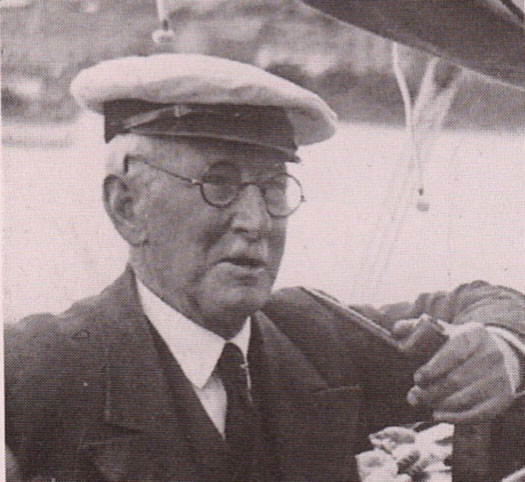
Henry P F Donegan (1870-1940), who gave his total support for the Fastnet Race from its inception in 1925.
Henry P F Donegan (1870-1940) was in his way quite a force in sailing, and in the life of Cork and Ireland. A small man of notable energy sharpened by being a teetotaler, he was playing a key role in Cork Harbour sailing from an early age. When the plans for the new Cork Harbour One Designs were being discussed with William Fife in 1895-96, Donegan was secretary to the owners' group, and though he never owned a CHOD himself, he was renowned as a helmsman in the class, and as an amateur painter he also recorded their earliest appearances.
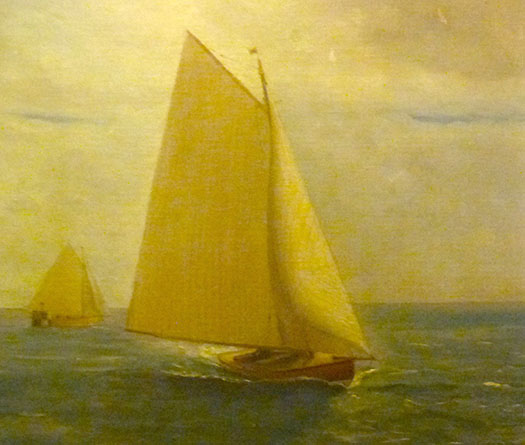
Cork Harbour One Design as painted by Harry Donegan. Although never an owner in the class, he was secretary to the class association at its foundation in 1896, and was noted as a very able CHOD helmsman.
But cruising and offshore sailing were his greatest passion, and he made some coastal ventures in very small craft. By 1912 he had produced pioneering harbour and anchorage plans for the magic places of West Cork, and this early interest in sailing directions was part of his enthusiasm for the notion of an Irish Cruising Club, though it was 1929 before he and a friend met while cruising West Cork, Billy Mooney of Howth, were finally able to bring the ICC into being.
Back in 1920 meanwhile, the Cork Harbour cruiser fleet had acquired a handsome addition, the 18-ton Nicholson cutter Gull, bought in the southwest of England. For some reason, whoever brought her to Cork had to sell her the following year, and thus in 1921, Harry Donegan acquired his dreamship, the sailing love of his life.
These were difficult times in Ireland, with the country emerging from the War of Independence only to be plunged into the Civil War of 1922, fought over the acceptance or rejection of the Treaty which had ended the War of Independence. Initially, the anti-treaty forces had control of Cork, but as the summer of 1922 progressed, the Government's pro-treaty forces under the command of Emmett Dalton gradually closed in to free the southern capital.
Communications between Dalton and his commander Michael Collins in Dublin were becoming increasingly difficult as roads, railways and telegraph lines between the two cities were disrupted by anti-treaty guerilla groups. A system had been worked out whereby communications between Dalton and Collins were carried personally by Collins' feisty sister, Mary Collins-Powell. But when all the usual means of getting her to Dublin with the vital dispatches were finally gone, Harry Donegan – who had been the leader of the pro-Home Rule Redmondite Party in Cork though not himself an active politician - offered to sail Collins' sister aboard Gull to Rosslare Harbour, where the east coast railway was firmly under government control all the way to Dublin.
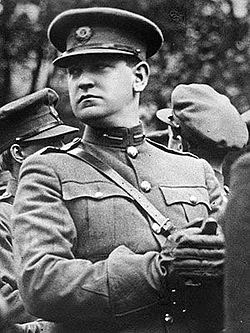
Michael Collins, Commander-in-Chief of the Government Forces after Independence. As the Civil War built to its climax in West Cork in 1922, Harry Donegan carried despatches aboard Gull from the Government forces in Cork for Michael Collins at HQ in Dublin, as rebel guerillas had cut off all other lines of communication.
For this venture in early August 1922, he assembled a crew of several professional talents. Harry Donegan was a solicitor, his first mate was Dr Gerald Ahern the local doctor, and in their sailing and any spiritual needs, they were helped by the third crewman, Father Donal Murphy O'Connor.
Easterly winds hampered their progress towards Rosslare, but fortunately Government-controlled Waterford offered taxi communication with Rosslare, so they peeled off into port and soon Mary Collins-Powell and the dispatches were in Dublin and Gull cruised back to Crosshaven. With the situation clarified for the general staff in Dublin, plans could be finalized for the freeing of Cork, and Emmett Dalton and his men soon had the job done.
Which was just as well for our three heroes on the Gull. While the city may have been coming rapidly under Government control, close to the south the countryside was still full of anti-treaty units. It was Civil War in all its horror of brother against brother, friend against friend. When the crew of Gull came ashore in Crosshaven after their successful little voyage, they were promptly captured by a local anti-treaty group, and imprisoned for some days in a shed.
But up in Cork, Emmett Dalton and his fellow commanders were going about their business with such efficiency that in Crosshaven the solicitor, doctor and priest - sailors all - were soon released unharmed. Peace returned to Cork Harbour. But as the main theatre of the Civil War moved ever more remorselessly towards its bloody denouement in West Cork, Michael Collins felt he could no longer be up in Dublin, remote from events in his home county.
Despite everyone else advising against it, he came to Cork to be with his men. He spent his final night in the Imperial Hotel in Cork, and with that city already showing signs of its civilized normality, who knows but he may have had time to meet up with Harry Donegan, for everyone in Cork knew everyone else, then as now.
Next day, the Commander-in-Chief headed west on his tour of inspection, and by evening General Collins was dead, killed during a spirited exchange of fire in which he personally got involved following an ambush by men who would have been his comrades-in-arms during the War of Independence.
The Civil War was already being won by the pro-Treaty forces, but the death of Collins undoubtedly speeded its ruthless conclusion, which included the government execution in November of Erskine Childers, another noted sailing man who had become embroiled in the Troubles. By 1923, Ireland was very determinedly getting back to normality.
In its own way, sailing made its contribution. In Dublin, self-taught yacht designer John B Kearney started construction on his masterpiece, the 38ft yawl Mavis. From Foynes on the Shannon Estuary, Conor O'Brien departed in his 42ft ketch Saoirse – newly-built to his own design in Baltimore, West Cork - to sail to Dun Laoghaire to begin what was to become his epic pioneering voyage, round the world in two years south of the great Capes.
And in Crosshaven, Harry Donegan kitted out the Gull to make a long cruise to the west coast of France which so clearly demonstrated the yacht's speedy sea-keeping ability that when, towards the end of 1924, the notion was first being aired of the new 630 mile ocean race from the Solent out to the Fastnet Rock, then back to a finish at Plymouth, he was soon keen to get involved and - unlike some others - he maintained his enthusiasm and was there for the starting gun.
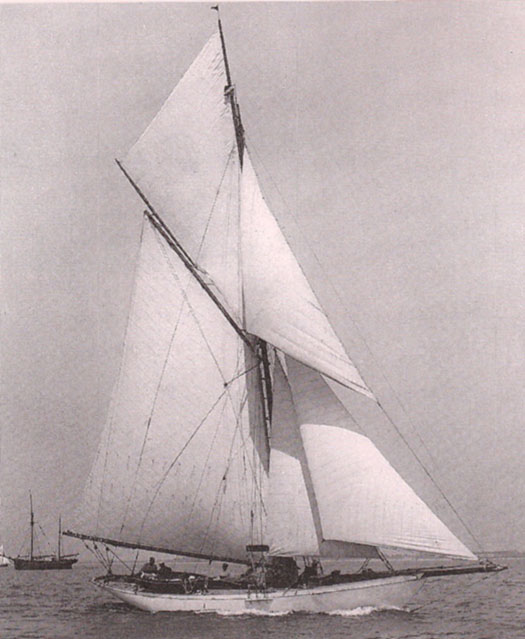
Gull at the start of the first Fastnet Race, August 15th 1925
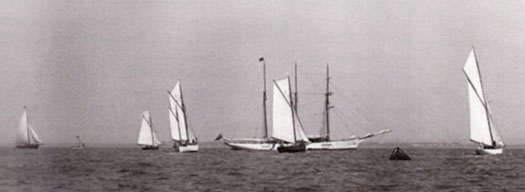
With the seven boats in the first Fastnet Race in 1925 having to beat eastwards out of the Solent from the start at Ryde, it was Gull (right) with her large sail area which soon showed ahead after making a good start. She was to lead for the first third of the 630 mile race.
In fact, Gull had the best of a fairly leisurely start off Ryde heading east out of the Solent on August 15th 1925. The Donegan cutter had much the most modern hull in the entire Fastnet flotilla, and with her huge if demanding rig, she was fastest in anything up to Force 4.
Thus she led by a good margin going outwards past the Scillies, but with sailing power soon lessened through broken topsail halyards, the succeeding stages weren't so happy, and the bigger Jolie Brise was first to the Fastnet with time in hand on the Irish boat. Heading back towards Plymouth in a freshening south'wester with the lee rail under, Harry Donegan updated his log on August 20th:
"The cabin swing-table is doing its level best to assassinate me. I have been struck in the chest and chin, while the weighty box beneath is making frantic efforts to amputate one or both of my legs"
A slight navigational error brought Gull in close north of Land's End in poor visibility, and by the time she'd made good this mistake in strong onshore winds, Jolie Brise – which was allowing her 9 hours on handicap – was well into Plymouth as the winner, while second went to the Royal Engineer's determinedly-sailed 38ft gaff cutter Fulmar, with Gull third.
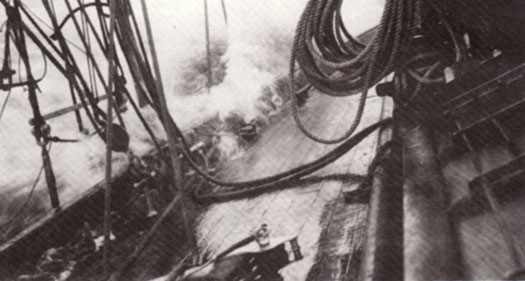
Gull making knots in the open ocean, headed for Plymouth from the Fastnet on August 20th 1925. Up-dating his log, Harry Donegan wrote: "the cabin swing-table is doing its best to assassinate me...."
Those accustomed to more recent Fastnet Races and the carnival atmosphere in the huge fleet at the finish will be intrigued by the picture Harry Donegan conveyed in the Autumn of 1925, responding to a letter from Weston Martyr, about the atmosphere which prevailed in that tiny first Fastnet flotilla as they lay to their anchors in Plymouth:
Cork, 12th November 1925
"I was exceedingly glad to get your breezy letter which was redolent of the salt sea, and may I say here that if my crew favourably impressed you, you in turn made a very lasting impression upon us all, short though our opportunities were for sizing each other up. I must say, further, that we were all appreciative of the excellent type of sportsmen that now go to constitute the Ocean Racing Club.
Take, for instance, these boys in the Fulmar. Under ordinary circumstances we, as traditional Irishmen, should have been in their wool after the finish, yet we all fell around each other's necks with the true spirit of comradeship and made merry on both ships.
Martin, needless to say, shines out as a most excellent type. We were particularly pally with the crew of Jolie Brise later, and doubtless had North Star and Banba moored near Drake's Island, we would all have fraternized in the same way.
I have raced a good deal and know the petty little feelings that sometimes prevail after the finish of an ordinary race. If one's boat has done excellently up to a point, and has then been pipped by horrible ill-luck, sometimes there is not a superabundance of joy.
Contrast that with the congenial assembly in Plymouth, and do you not share with me the impression that the Ocean Race has merits beyond the most optimistic hopes of the originators, in that it brings out the best in us and creates a feeling of good fellowship amongst the competitors that no other class of racing is calculated to do so thoroughly and effectively."
With the race successfully launched, the new Ocean Racing Club at its first formal meeting in October 1925 considered ways changing the course to make it of greater interest to yachts based outside the Solent-Plymouth nexus, but Harry Donegan was having none of it, and in writing to Weston Martyr he did much to ensure that the classic Fastnet Race was kept in place:
"I do not see how the Committee are ever going to change the course, that is if they want to stick to the 600 miles, and I confess I cannot at all see how they can ever improve on it. There is ocean sailing enough to satisfy a glutton, a freedom from sand banks, and only good honest rocks to think about."
Nevertheless we have to remember that back in the late 1920s and early 30s, it took real determination to keep it going at all, first as an annual event, and then after 1931 as biennial. Certainly there were those for whom, having done the first race of 1925, doing it again was of no interest. But Harry Donegan was one of those who considered participation in the 1926 race was essential, even if he was now 56 years old and no longer in the best of health.
The fact that he willingly took Warwick Tompkins aboard as a last-minute addition to the crew also suggests that he may have had difficulty in assembling a full ship's complement back home. And the race was now acquiring further contentious issues. There were those who still said it shouldn't happen at all, but others were so enthusiastic that boats were being purpose built for the Fastnet Race. A wealthy Scot, Norman Baxendale, had commissioned William Fife to design and build a Bermudan rigged cutter which would exactly fit the Ocean Racing Club's new upper limits of LOA70ft, and LWL50ft.
This was Hallowe'en, which was such a mighty leap forward in the concept of what constituted an ocean racer that most of the old salts considered her plain unsporting. We know Hallowe'en so very well now, for after an adventurous life on both sides of the Atlantic, she has been restored and is currently owned by an Irish syndicate who from time to time base her at the Royal Irish YC in Dun Laoghaire, though perhaps from respect for her history, the home port inscribed on her elegant counter is Cork.
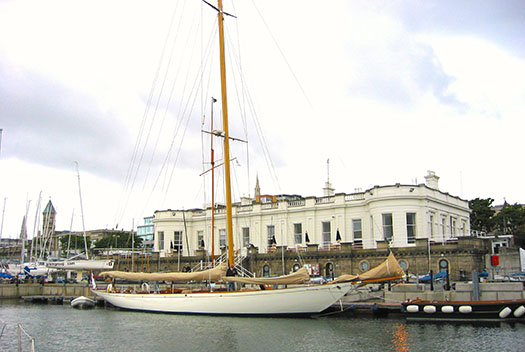
The 70ft Fife cutter Hallowe'en, which set a course record for the Fastnet Race in 1926 which stood for 13 years, and was only bested by an 88-footer. Hallowe'en is seen here at the Royal Irish YC in Dun Laoghaire, and is owned by a syndicate of RIYC members. Photo: W M Nixon
But back in 1926, with a fleet of eight boats racing the second Fastnet, Hallowe'en was so much on her own that despite some strong winds as she came in past the Lizard heading for the finish, she experienced little of the southeast gale which created mayhem out at the rock, with some boats hove to for a day and more, and Gull – which had been doing rather well, third on the water at the rock – eventually making her dramatic exit towards Cork Harbour in the intense little local low which blasted the smaller boats.
Hallowe'en established a course record which stood until 1939, by which time even larger boats were allowed to compete, and her time was bested by the Kriegsmarine's 88ft Gruber yawl Nordwind, whose German naval crew did not endear themselves to the organisers by their exuberant use of full uniform and Hitler salutes at the prize-giving. In fact, it wasn't until Ted Turner's 12 Metre American Eagle zapped round in style in 1971 that the Hallowe'en course record was beaten by a boat of comparable size.
So back in 1926 she was sensational, yet in simply designing to the upper limits, William Fife took no other account of the developing RORC measurement rule, and Hallowe'en had a rating so stratospheric that she finished third on corrected time, the winner being the 20-ton yawl Ilex, sailed by those very determined Royal Engineers.
As for Harry Donegan and Gull, that was their last Fastnet participation, but they were regular contenders in other events., particularly the RORC Falmouth-Clyde races during the 1930s when the skipper's son Young Harry was becoming involved, and of course the skipper himself was involved with huge and infectious enthusiasm for the Irish Cruising Club from its formation in 1929. In the end, passage races to West Cork and cruising that incomparable area became his fulfilling pleasure, and he'd a final magnificent sail from Schull back to Crosshaven before his death in 1940, aged 70.
His son Young Harry took up the reins, and in 1946 he sold Gull to England, and replaced her with the much racier Fife-designed Sybil from within the Cork Harbour fleet. 1947 was to be the first full year with the new boat, and he took her round to Dublin Bay for the Dun Laoghaire to Clyde Race, but tragically he was drowned when the dinghy filled in a near gale in Dun Laoghaire Harbour while returning aboard from the pre-race briefing. Like his father, Young Harry was a teetotaler, but in his tireless efforts to save his shipmates, he became exhausted and was the only one of Sybil's crew lost in this accident which reverberated sadly through Irish sailing for decades.
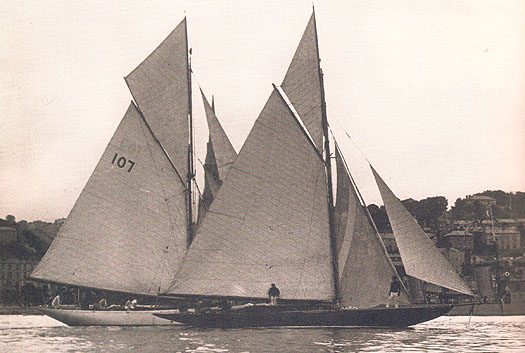
The two yachts which brought triumph and tragedy to the Donegan dynasty – Gull and Sibyl off the Cobh waterfront during the 1930s. Photo courtesy Royal Cork YC
Young Harry's eldest son Jim then became head of the clan although still only a schoolboy, but over the years he showed the family's zest for offshore racing and successfully competed in many major events in a variety of craft. And in the best family traditions, he was also busy behind the scenes becoming a founding Commodore of the South Coast Offshore Racing Association, and then a co-founder (with Fintan Cairns) of the Irish Cruiser Racing Association in 2002.
We are now five generations down the Donegan line from the great Harry P F Donegan himself, and the current most visible carrier of the torch is his great-great-grandson Jamie Donegan, who is the very highly regarded bow-man aboard Anthony O'Leary's new boat, the red Ker 40 Antix, where the Donegan contribution to winning the recent British IRC Championship was particularly noted.
As for his extraordinary great-great-grandfather, he was the man whose crisp opinion on the attractions of the Fastnet course may well have been the key to its lasting appeal. And with every passing year, his very special and innovative contribution to Irish and international sailing and the development of offshore racing and proper cruising is more fully appreciated
Harry Donegan was rightly and fondly remembered by many, not least his former shipmate Warwick Tompkins. After Gull's enforced retirement from the 1926 Fastnet Race, the skipper worked out that if they caught that night's Cork-Fishguard ferry and had a bit of luck with train timetables in south Wales and southwest England, he might just be able to get Tomkins to Plymouth in time for the Fastnet Dinner in the Royal Western.
They made it by the skin of their teeth. And at the dinner, Harry Donegan made such an impassioned little speech about the contribution his new friend had made to the saving of the Gull that his fellow members of the Ocean Racing Club waived their normal insistence on completion of the Fastnet Race as being the requirement for membership of their club. Warwick Tompkins was elected to the ORC, soon to be the RORC, with acclamation.
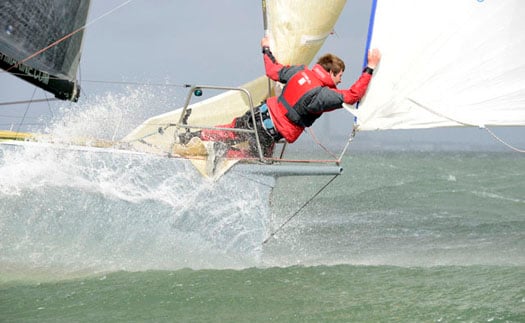
Doing that Donegan thing....Jamie Donegan, great-great-grandson of Harry Donegan, busy at his work as bowman aboard Anthony O'Leary's Antix. Photo: Rick Tomlinson
Rambler Breaks Caribbean 600 Record
George David's maxi yacht, Rambler 100 crossed the finish line in Antigua in the early hours of Wednesday morning in an elapsed time of 1 day 16 hours 20 minutes and 2 seconds.
Rambler 100 has broken the monohull race record set by race rival, Mike Slade's ICAP Leopard by nearly four hours.
Two of the world's most impressive racing yachts have been locking horns over 600 miles of high-speed action in a fight to the finish. Competing against each other for the first time and battling it out to snatch the record for the third edition of the RORC Caribbean 600.
32 other yachts from 15 different nations crossed the start line of the RORC Caribbean 600, off English Harbour in Antigua, Caribbean on February 21st. Most of the fleet is expected to finish over the next 24 hours.
Latest news on the race website: http://caribbean600.rorc.org/
Follow the fleet trackers online: http://caribbean600.rorc.org/race-information/tracking/2011-fleet-tracking.html
Middle Sea Race Starts on Saturday
Flying into Malta it's hard not to be struck by the landscape: the buildings all a blinding beige in the hot sun, the landscape fairly arid and dry. It's more reminiscent of the Northern African coast, which is only 155 nautical miles west. The island archipelago is at the crossroads of the Mediterranean situated, as it is, midway between Sicily and the coast of Tunisia. This year's fleet reflects that more than any year past, with numerous entries from throughout Europe, Russia, the United Kingdom and the United States.
One Irish boat, Legally Brunette, from Dun Laoghaire is entered in to the race.
This 31st edition of the 606-nautical mile Rolex Middle Sea Race begins this Saturday, 23 October from Grand Harbour. Registration closes on Friday, but by press time there were 83 boats entered from 18 countries. Included in this number and back to defend, are 2009 Overall Winner, Andres Soriano on the 21-metre mini-maxi Alegre (GBR), and Line Honours winner, Mike Slade on the 30.5-metre ICAP Leopard (GBR).
The race is organized and hosted by the Royal Malta Yacht Club, which moved into stylish brand new quarters overlooking Marsamxett Harbour, just prior to last year's race. The yacht club, with as rich and varied a history as this island republic, is one of the most hospitable anywhere and provides all sailors who make the effort to trek here, a warm welcome.
Yesterday, a low pressure system that swept through south of Sicily, with winds of 50 knots and 3 to 4 metre seas, which has delayed the arrival of some of the foreign fleet. Though some like Esimit Europa 2 (SLO) and Wild Joe (HUN) were already committed to crossing and so endured the conditions encountered enroute. The 30-metre Esimit had a lightening strike that took out the wind instruments at the top of its 44-metre mast. Meanwhile, Marton Jozsa's Wild Joe, a R/P Custom 60, which set out from Croatia on Friday, and then from Sicily yesterday morning, had a tough crossing, ripping both their mainsail and jib.
Many of the fleet is moored in Camper & Nicholson's Grand Harbour Marina and dockside there today there was a flurry of activity with crews effecting repairs or otherwise prepping for Saturday's offshore race. Tomorrow, Wednesday, there will be Coastal Race most likely around neighboring Comino Island. Some boats, though not all, use this race as a tune-up for the offshore.
Along the quay, there were country flags on the back of boats from Spain, Italy, Hungary, Slovenia, the UK and United States, as well as a local fleet of competitors from Malta. One would think the Maltese might have an edge – local knowledge of the area, perhaps – and in that group one of the ringers may well be Jaru (MLT), a J/133 co-skippered by John Ripard Jr. and his brother-in-law, Andrew Calascione. The close relations don't stop there, as half the crew are composed of their children, with a few close friends from the UK there to round out the crew.
Sailing onboard, as helmsman and watch leader, is 23-year old, Sebastian Ripard. This youngest of the Ripard generation is taking time out from his, and team mate Benji Borg's, campaign in the 49er class for the 2012/2016 Olympics. This 600+ mile race requires switching gears from 'around the cans'. Asked what he likes about this, his eighth, race, Sebastian said, "It's a beautiful race. I mean one of the marks is a volcano, which is often erupting! There's always a bit of everything in this race, tactically there are a lot of different points where the race compresses, so there's a lot of tricky areas: the Straits (of Messina), Stromboli, by Favignana, which make it challenging throughout. There are a lot of variables that keep on changing. And I quite enjoy the mental demands of an offshore race; it's more of an adventure. In his first go round in 2002, he racked up an overall win on the J/109 Jammin' (MLT) with – same as this year – his father and uncle. He followed that with a 2nd place in the J/109 Artie (MLT) with Lee Sartariano.
The J-Boat has a good track record for the race: a J/133 won its' class and placed 2nd overall in the 2008 Rolex Middle Sea Race. The 43-footer was Sailing World magazines' "Boat of the Year" award when it was launched in 2003 and the design has proven itself for performance cruising and offshore racing.
Almost all foreign competitors seem drawn to this unique race: a long offshore, anti-clockwise around Sicily, a few volcanoes, and some neighboring islands. Bryon Ehrhart owner and skipper of Lucky (USA), is one of those. Ehrhart, from Chicago, first raced the boat in the 2006 Newport Bermuda Race. Since then they have competed in the 2007 Transpac Race, the 2008 Chicago Mackinac, and the 2009 Rolex Fastnet Race.
His crew are a group of strong amateurs, with a few professionals that have sailed together for years. For the most part, they are Etchells (one-design) sailors, and plan to bring that level of intensity and competitiveness from the small boat fleet to a big boat offshore program.
Ehrhart said, "We have an interest in doing the truly great ocean races and certainly the Rolex Middle Sea Race is one of them. It's a race that I have read about over the years and have thought that – because of the course – would be strategically and tactically challenging, maybe even the most challenging we have done or will ever do.
"A fantastic amount of preparation has gone into getting the boat ready for this race and we hope we are up to all that we may encounter. We have converted this TP52 to an IRC offshore boat. We do a couple of big events a year and this race is the only offshore event we are doing in 2010: it is a race of the quality that is worth organizing our year around. "
Thursday is a Crew Party at the Royal Malta Yacht Club, and on Friday there will be Skipper's race and weather briefing. The Rolex Middle Sea Race commences on Saturday, 23 October 2010. The final prize giving is on Saturday, 30 October. George David's Rambler (USA) established the current Course Record of 47 hours, 55 minutes, and 3 seconds in 2007.
Leopard Seeks Round Britain and Ireland Record
ICAP Leopard's crew will be made up of the usual collection of established ocean racers, including leading solo round the world sailor Sam Davies, who currently holds the monohull course record of six days, 11 hours, 30 minutes and 53 seconds. Sam broke the course record with fellow round the world sailor Dee Caffari aboard the IMOCA 60 Aviva in 2009. This year sees a highly competitive fleet, including Telefonica Azu's VO70 and the IMOCA 60 Artemis Ocean Racing, meaning the crew will need to push the boat hard to ensure line honours.
Mike Slade, commented: "Once again we have a great team onboard for this classic offshore race. Sailing around Britain and Ireland produces some of the most complex weather systems in the northern hemisphere, so we'll have to be on our toes to ensure we give ourselves a chance at beating the record."
Sam Davies, revered round the world sailor, said: "As current course record holder and having sailed the Sevenstar Round Britain and Ireland Race a number of times before, I cannot wait to get started. The nature of sailing around an island means that the weather systems are not consistent in direction and therefore produce very changeable weather. This makes it all the more challenging and one of the most interesting offshore races around."
Starting on the Royal Yacht Squadron line in the Solent, ICAP Leopard will head out of the Solent and along the South Coast, past Bishop Rock before heading north into the Celtic Sea. Leaving Ireland to starboard, the journey will then see the boat begin a 230 mile open water leg past St Kilda and the Flannan Isles. Through changeable and challenging weather conditions, the boat will continue around the Outer Hebridies, past Muckle Flugga and then down the East of the Britain. Having dodged the busy shipping lanes and oil rigs in the North Sea, the crew will undertake a final push past Dover finishing at the Royal Yacht Squadron line.
http://www.leopard3.com and follow the link to the Round Great Britain & Ireland Race pages.



























